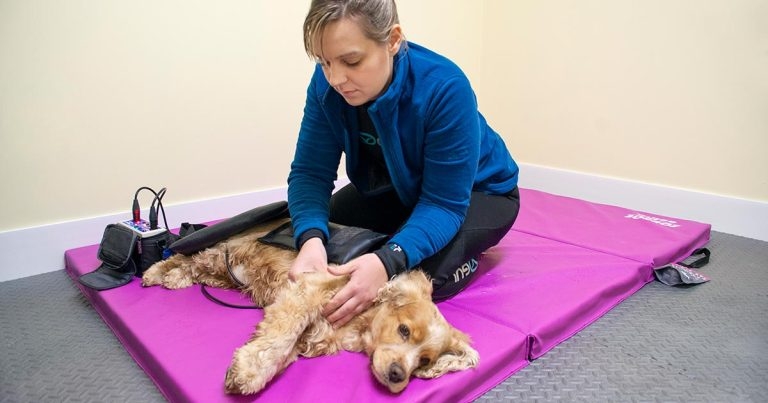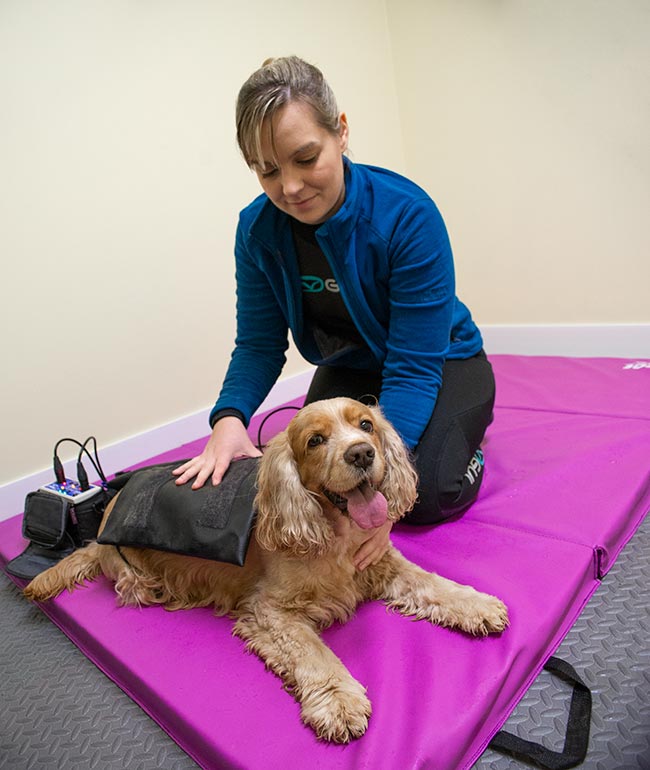12 Nov 2021
Leanne Dobrowolski describes the role physical therapy plays in a multimodal approach to treatment of these patients, and why communication is key to success.


Neurological conditions vary, but they are caused by spinal, neuromuscular or intracranial conditions and require a specific care plan – including rehabilitation techniques – to provide the patient with the most efficient recovery or supportive care.
Veterinary medicine is fast developing, with an increase in diagnostic aids and the understanding of neurological disease that allows veterinary professionals to triage and treat the condition in the most effective way.
A multimodal approach is key – and good nursing care is vital to maintain the clinical aspect, but also the overall demeanour and comfort of the patient. A physical rehabilitation plan is vital in the treatment of patients in the recovery period or with ongoing neurological disease.
Common conditions are generally neuropathies affecting the peripheral system, strokes, spinal conditions or idiopathic conditions.
At times limitations may exist that have an overall impact on the diagnostics available to specific cases, which will also then, as a result, affect the treatment options and rehabilitation techniques or methods.
In practice, a big factor may be client compliance and diagnostic aids available within budget. This can be challenging at times, especially when treatment is crucial at that time and the condition may deteriorate without suitable treatment; whether it be surgical, conservative or supportive.
The care with many of these cases is usually ongoing, and will require commitment from the owner and good communication from veterinary professionals.
When approaching clinical cases, as a rule, a lot can be gained from patient observations and presentation; in some cases, observations of the patient’s posture, gait and overall body condition will give a good indication of patient ability and condition.
The veterinary surgeon (VS) examination will then hopefully indicate a diagnosis, and the most suitable diagnostic aids and treatments available that the client can comply with.
Hospitalised patients, or patients seen in nursing clinics, can display signs of neurological conditions, weakness or abnormalities – and as seen in Table 1, these external indicators could provide a lot of information when writing observations for ongoing cases that are hospitalised, or patients that have been admitted or seen initially by the any veterinary professional.
A clinical record will be made – whether it is on hospital sheets or a computer database – and this will become a reference to identify improvement or deterioration over a period of time.
These observations in Table 1 are also good markers to identify mechanical abnormalities or weakness in specific limbs – and as an RVN this can be used throughout nursing clinics to refer back to the VS for further examination and diagnosis of various orthopaedic or soft tissue conditions.
| Table 1. External indicators for neurological conditions, weaknesses or abnormalities | |
|---|---|
| Observation | |
| Behaviour | Overall demeanour – signs of pain, discomfort, agitated |
| Posture/tail position | Hunched, tense, favouring one side, tail to left/right/tucked, under/wagging |
| Limb weightbearing | Weight shifting to one side, avoiding one limb, knuckled, does not want to stand or push off from specific limb |
| Nail condition | Scuffed or worn down on one side, wounds on distal limb (new or old?), hair loss, abrasions |
| Limb position | Limb pushed laterally/forwards, abnormal position, patient aware of foot/limb position?, sores on leg/foot? |
| Symmetry of musculature | Muscle loss – is muscle mass even? |
| Gait | Foot placement, toe dragging, lateral placement, ataxia |
The observations in Table 1 are useful when communicating with the treating VS as, at times, a patient may present differently at different assessment intervals – and this helps the VS to make clinical decisions based on all findings throughout the patient’s care.
When looking at an individual patient, the breed, body shape, age, size and temperament should all be considered when configuring a nursing plan – the patient as a whole, and its behaviour, will have a direct impact on its progression and the ability to nurse it.
Movement, balance and coordination in animals is commanded by the proprioceptive system, then carried out and organised by sequences that are powered by muscle contraction. Receptors involved in the proprioceptive system are located in the skin, muscles and joints, and afferent nerves have an impact on limb position and placement.
Patients with neurological conditions have a “block” or “factor” that inhibits this normal sequence; therefore, externally we see abnormalities in gait, foot placement or balance (Proske and Gandevia, 2012).
This is why a multimodal approach is efficient, as physical therapy techniques can help stimulate these sequences along with maintaining good tissue health and encouraging a positive patient demeanour.
Physical therapy not only has biomechanical benefits, but also allows trust to be gained between patient and nurse/therapist with it being a positive part of a patient’s care during its stay in practice – especially when nursing a recumbent patient.
In human medicine, physiotherapists are used as part of the treatment plan in many clinical cases, including musculoskeletal, intensive care, stroke and general medicine.
In veterinary practice, the role of the veterinary physiotherapist is developing, with an increase in referrals and process to consider physical therapy as part of the treatment plan alongside other surgical and conservative treatments.
In‑practice physiotherapy techniques would improve patient care and assist with a faster recovery, therefore improving patient condition and ability; however, in reality a physiotherapist cannot be at hand to provide these techniques, especially in first opinion practice, and it would be beneficial to assist RVNs in the understanding of basic techniques such as passive range of movement (PROM) and massage to allow for initial care.
Physiotherapy aims to optimise the potential of the patient (McGowan et al, 2007), and it concentrates on physical problems along with pain, muscle loss and sensory input (Veenman and Moser‑Kats, 2004).
While a veterinary nurse can carry out basic physical therapy techniques, clinical reasoning is essential – and techniques should always be followed under veterinary direction, along with the RVN being competent, as it is imperative it does not have an adverse effect through poor technique, or techniques being used when contraindicated.
Overall, the clinical aim of rehabilitation techniques are not only to “rehabilitate”, but to also minimise onset, progression, limitations and other clinical signs by preventing further disease, injury or conditions occurring secondary to the primary condition.
All animals with movement/conformation abnormalities, weakness or physical limitations are candidates for physiotherapy or rehabilitation, which is why predominantly neurological and orthopaedic cases are all candidates for physical therapy techniques (Levine et al, 2005).
The VS will make primary decisions following a neurological and orthopaedic examination, followed by diagnostics to establish the diagnosis. This evaluation will then result in treatment in practice or a referral to a physiotherapist to then carry out their own assessment, which includes biomechanical, neurological and physical evaluation through palpation techniques and range of motion (ROM), along with history taking and general observation.
When considering hospitalised patients within a practice without access to a physiotherapist, this can open further opportunity for the RVNs to complete further CPD and learn basic physiotherapy techniques to support patients, and build client and patient relationships.
This would be beneficial in many clinical cases – not only orthopaedic – and it would allow the RVN to build a good relationship with patients and improve their overall demeanour while in hospital.
As a result, the patient will have improved recovery and a good association while in practice, along with building relationships with the staff.
A wide range of manual techniques exist, including massage, joint manipulation, stretching and exercise prescription.
Overall, basic techniques used may be massage and PROM following agreement from the VS for that specific case. Manual techniques – such as massage and PROM or ROM – help maintain tissue health, and try to preserve and maintain a patient’s ability, which, therefore, will assist with improvement and progress of the patient and its clinical condition.
Massage is the manual manipulation of the soft tissues of the body and can be used to help the therapist relax the patient, creating a good relationship between therapist and patient.
Massage benefits the patient by increasing blood flow, restoring mobility, promoting lymphatic flow and drainage, reducing pain and muscle spasms, and promoting healing (Scott, 2005). This is a very valuable technique as it can be demonstrated to owners and carried out at home, allowing for tension to be released and promoting tissue healing with increased frequency.
PROM is when a specific joint is moved through its available angles, which helps maintain the current status of the patient and joint health.
When carrying out ROM, it is essential care is taken to avoid overstretching or abnormal movement in the joint, as this could have an adverse effect or be uncomfortable for the patient.
Many conditions benefit from the use of PROM, including neurological cases, paralysed/recumbent patients, and patients suffering with OA (Veenman and Watson, 2005). This technique is also deemed effective in patients to help combat physiological changes such as pain, inflammation and disuse of the limb (Bromiley, 1991; Shumway, 2007).
ROM is used routinely in human medicine, and it is clear it helps in the recovery and maintaining patients.
Overall, a multimodal approach is essential for treatment in neurological cases – and communication is key between the VS, veterinary nurse and veterinary physiotherapist.
The patient is of the highest importance, along with the client, and good communication enables the multimodal team to provide the best care possible.
Leanne Dobrowolski
Job Title